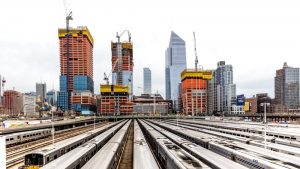November 28, 2017
by Jennifer Urrutia
Residents of the New York City “concrete jungle” are no strangers to construction and development. And while development is booming in New York City, there has never been a project quite like
Hudson Yards, the largest private development in the history of the United States. Hudson Yards is located in Midtown West and will consist of 18 million square feet of office, residential and retail space, three parks, and 14 acres of gardens and plazas. It will be populated by 40,000 workers and residents, and up to 65,000 visitors per day. The vast scale of the project, coupled with building a platform to span active train tracks, posed new levels of complexity for Related Companies, the real estate firm responsible for the project.
The GreenHomeNYC Forum, “Spotlight on Hudson Yards”, was co-hosted with AEE-NY and ASHRAE New York at the New York Institute of Technology, and drew a crowd in excess of 80 attendees. Three senior executives from Related Companies took the stage to discuss Hudson Yards’ operational sustainability initiatives, energy performance tracking, and building commissioning and asset management.
A Clean and Responsible Neighborhood
Charlotte Matthews, Vice President of Sustainability for Related Companies, kicked off the session with an overview of the project, stating that Hudson Yards is the largest development in U.S. history. The first building, 10 Hudson Yards, is the first LEEDv2009 Platinum building over 1MSF in the U.S. and the first LEEDv2009 Platinum office tower in New York State. In order to achieve this feat, 10 Hudson Yards used wireless occupancy sensors and reduced lighting load by 40% over conventional designs. Hudson Yards operates as a connected neighborhood through a series of systems that include wifi networks and even a 13MW cogeneration plant on top of the retail building at 20 Hudson Yards, which will avoid an average of 23,500 MT CO2/year of GHG emissions. In addition to reducing CO2 emissions equivalent to 4,900 cars or 2,000 homes, the cogeneration plant will reduce the burden on the local electricity distribution grid. As the Vice President for Sustainability, Matthews emphasized the clean and responsible neighborhood factors that Hudson Yards aims to achieve.
Tracking Energy Performance
Frank Norcross, Vice President of Related Companies, highlighted the demand response capabilities of 10 Hudson Yards, along with the effort to create enhanced visibility into energy consumption for tenants through the use of web applications. Transparency to tenants with respect to energy is a primary objective for Norcross’ energy management practices at Hudson Yards. Norcross underscored the use of data analytics and applications to “empower operators” and help them understand the impact of building operation on energy consumption. Participation in the oversight of the 1.2MW cogeneration plant in 10 Hudson Yards is one of Norcross’ responsibilities. With this in mind, he related a collaboration between building engineers and the energy management team to help improve cogeneration plant performance using a combination of data analytics and field measurements.
A Holistic Ecosystem: Fusing Sustainability and Energy Performance
The final speaker of the evening was Fred Knapp, Executive Director of Related Hudson Yards Manager and Acting COO of Related Management Company’s Commercial, Retail and Residential portfolios. Building on the comments regarding sustainability by Charlotte Matthews and the energy data driven efforts by Frank Norcross, Knapp discussed the efforts of Hudson Yards to operate as a holistic ecosystem. He noted that buildings and people are connected and must work with each other in a symbiotic network. “Experience and data driven decisions define the goal of the Hudson Yards,” Knapp explained. He highlighted the need for disparate building functions, such as vehicle management and energy management, to work collaboratively in order to be effective. While efficiency is an objective for Hudson Yards, providing an exceptional customer experience for both tenants and visitors is one of Knapp’s key goals. To that end, Knapp wants Hudson Yards to provide an unparalleled experience with an efficiency currently not seen in the market.
10 Hudson Yards opened in mid-2016. The remaining buildings of Hudson Yards’ Eastern Rail Yards will open by late 2018, into 2019.



